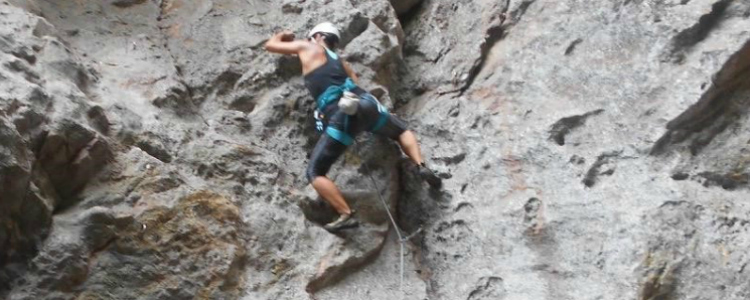Climbing into My Body
Eating disorders disconnect sufferers from healthy intuition by fixating on trivial externalities, falsely assigning meaning to numbers, objects, and food in an effort to soothe a damaged psyche. Having an eating disorder is living half in the failures of the past and half in the dreaded unknown of the future, and never fully aware of the present moment.
From my time as a patient in residential treatment centers, I know that mindfulness is presumably an antidote to the core issues at the crux of eating disorders. However, mindfulness for me is not achieved in an air-conditioned room with tapestries aimed at concealing the industrial fluorescent lights. About to surrender any and all attempt to incorporate mindfulness into my life, I discovered that for hyperactive, neurotic me, mindfulness is not all yoga and guided imagery—it’s chalking up, tying in and vertically ascending granitic walls. It’s rock climbing.
After years of fighting anorexia and bulimia, I suffered a critical case of “eating disorder treatment fatigue.” Ambivalence, ever so pervasive in eating disorder patients, crept in as I treaded the thin line between moving forward with my life goals, or letting my disease suck away my tenuous vivaciousness.
As non-traditional as it sounds, rock climbing is an essential piece to the puzzle of my recovery journey. New to Santa Cruz, a laid-back beach town in central California, south of my childhood home, I stumbled across a new medicine: connection, commitment, and community amongst other like-minded adventure-seekers and outdoor enthusiasts at the Pacific Edge Climbing Gym.
Looking back at myself as a kid, not only was I extremely active, I also loved the excitement of the outdoors. Quirky and not stereotypically “girly,” I made an easy target for bullying and name calling. I believe that if only I were “good enough,” I could be praised instead of ridiculed, so I put all my energy into become the best athlete. Exercise became my escape, my haven and focus. It didn’t take long until my perfectionistic tendencies overpowered ration, and my eating disorder took a toll on my body. At age 18, one week after starting collegiate lacrosse, I suffered a catastrophic knee injury, which would require major reconstructive surgery.
With the erasure of my identity of an athlete, I lost touch with my values. I lost touch with that energetic girl, drawn to others, human and otherwise, as well as my curiosity, my adventurous spirit, and my innate eccentricity. With rock climbing, I relearned to embrace these qualities.
Locating and rebuilding the shattered pieces of my lost self did not happen overnight. I did not feel confident the first time I entered the climbing gym. When trying on a harness after three years of steady, necessary weight gain, I felt the leg loops dig into my thighs. I compared my body against others in the gym, while ignoring the diverse phenotypes of physical traits present. My disease butted into my thoughts, “You are too fat, too heavy, too tall, too weak and too clumsy for this sport.”
“Excuse me, are you new here? Do you need someone to belay you?” Three women interrupted what would have otherwise been an endless pit of self-loathing and brought me back to the present.
“Sure, but I am kind of new.”
These three women were the first of many new faces who would soon make up my social network. Instead of dreading stationary gym machines after work, I left eager to play on new, exciting, and gradually more challenging indoor climbing routes.
In belaying I learned how to encourage others. In being belayed, I learned to trust others. In climbing, I learned to trust my body for the incredible things it is capable of doing—gravity defying things. In the climbing community, not only did I find that sense of inclusion I desperately craved, I learned that there is no ideal body for the sport. I never feel pressure to change my diet, lose weight, or count calories. I believe this attitude separates climbing from other sports or fitness trends. In fact, after an hour of solving the puzzles on the wall, we would unwind over burgers and beers at the brewery across the street, catching up, planning future outdoor adventures, and exchanging anecdotes.
From the experts, I learned the safety techniques, knots, and gear required for the outdoors. From experience, I learned that certain types of climbs, such as ones requiring the use of upper body strength on an overhang, are harder for me than other climbs because of how I am built. This is frustrating but not a personal failing. Instead, I learn to use my unique physiological or biological attributes such as my height, age, flexibility and lower body strength to excel at climbs my shorter or older climbing kin find impossible.
When adequately prepared to move from the indoor arena to the outdoor crags, a trusted female mentor with a penchant for sport climbing taught me the basics of lead climbing at the pinnacles. Lead climbing (either “traditional” or “sport”), unlike most gym climbs (top-rope) where the rope goes through an anchor at the top of the route, involves taking the rope with you and attaching it to fixed protection (bolts or pieces of gear) on the wall at certain intervals. The risks of lead climbing are higher, as falls can be much larger distances than on a top rope and, therefore, mindfulness is a necessity.
Reconnecting with my adventurous side in the elements left me feeling elated and inspired. While meticulously scanning the rocks for nooks, crannies, cracks or jugs, everything else is white noise. I never knew mindfulness before, because I never felt that my immediate safety necessitated this knowledge, until that first time I led a climb. On a rock wall with nothing pulling me up beside myself, the repercussions of berating myself for a missed hold or obsessing on my next move can lead to a fall, which could lead to serious injury, if unprepared.
Climbing involves taking calculated risks, something I have to do in recovery. Sometimes I feel stuck with a certain challenge, crag, or style of climbing, and sometimes I feel stuck with my recovery. When trying new routes, especially on sport climbs, I need some reassurance and outside input. Similarly, when I am apprehensive about a certain barrier to my eating disorder recovery, I reach out to my treatment team and trusted friends for a different kind of reassurance and input.
I am not recovered from my eating disorder, but I truly believe I am closer to reaching my recovery than before I discovered climbing. The sense of pride I feel when reaching the top of climb is truly rewarding. Every day I get to climb, I leave grateful and in a state of awe of how resilient my body is and what it is capable of.
Originally from northern California, Julia is a current postgraduate student in Marine Biology and Ecology at James Cook University in Townsville, Australia. She struggled with anorexia, bulimia and binge eating disorder since 14 years old (currently 27). For Julia, the most beneficial form of therapy has been has re-connecting with her values and passion for protecting the natural world. She finds peace and quiet underwater or high up climbing rock faces on mountains.





